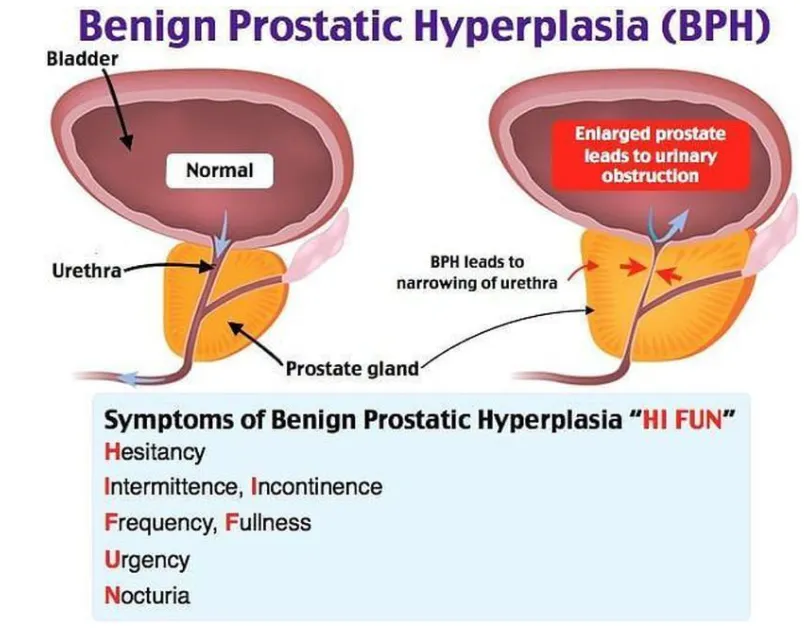ETIO-PATHOPHYSIOLOGY
-
The etiology is unknown but probably involves hormonal changes associated with aging.
-
Multiple fibroadenomatous nodules develop in the periurethral region of the prostate, probably originating within the periurethral glands.
-
The lumen of the prostatic urethra narrows and lengthens, progressively obstructing urine outflow.
-
Therefore, etio-pathological changes are multi-factorial:
- Smooth muscle hyperplasia
- Prostatic enlargement
- Bladder dysfunction
- Input from the central nervous system
-
Increased pressure associated with micturition and bladder distention can progress to hypertrophy of the bladder detrusor, trabeculation, cellular formation, and diverticula.
-
Incomplete bladder emptying causes stasis and predisposes to calculus formation and infection.
-
Prolonged urinary tract obstruction, even if incomplete, can cause hydronephrosis and compromise renal function.
SYMPTOMS AND SIGNS
Lower Urinary Tract Symptoms (LUTS)
Often progressive, known collectively as lower urinary tract symptoms (LUTS):
- Presents with both storage symptoms:
- (frequency, urgency, nocturia, and incontinence) and
- Voiding symptoms:
- (weak stream, dribbling, dysuria, straining).
Differential Diagnosis for LUTS
- Overactive bladder
- Prostatitis
- UTI
- Neurogenic bladder
- Urethral stricture
- Bladder Ca
- Prostate Ca
Symptoms and Signs
-
Frequency, urgency, and nocturia are due to:
- Incomplete emptying and rapid refilling of the bladder.
- Decreased size and force of the urinary stream cause hesitancy and intermittency.
-
Pain and dysuria are usually not present.
-
Sensations of incomplete emptying, terminal dribbling, overflow incontinence, or complete urinary retention may ensue.
-
Straining to void can cause congestion of superficial veins of the prostatic urethra and trigone, which may rupture and cause hematuria.
-
Straining may also acutely cause vasovagal syncope and, over the long term, may cause dilation of hemorrhoidal veins or inguinal hernias.
Symptoms of Benign Prostatic Hyperplasia “HI FUN”
- Hesitancy
- Intermittence, Incontinence
- Frequency, Fullness
- Urgency
- Nocturia

Urinary Retention
- Some patients present with sudden, complete urinary retention, with marked abdominal discomfort and bladder distention. Retention may be precipitated by any of the following:
- Prolonged attempts to postpone voiding
- Immobilization
- Exposure to cold
- Use of anesthetics, anticholinergics, sympathomimetics, opioids, or alcohol